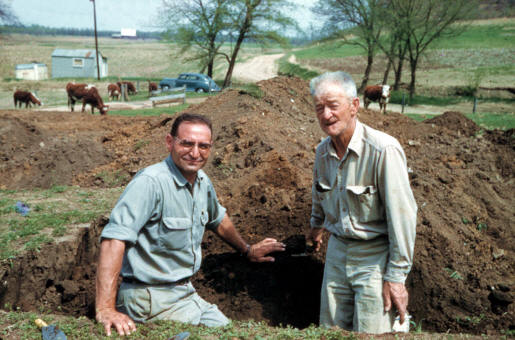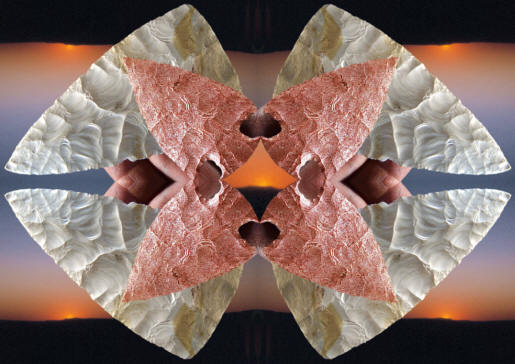|
"In the summer
of 1940 I made an archaeological survey trip through Calhoun County, and
by a "chance step" at the home of Andrew Snyders was rewarded by
information which led to an investigation of the old Indian village
occupying lands on both Snyders and Freidel farms."---1952,
W. L. Wadlow, "The Snyders Site," The Greater St. Louis
Archaeological Society, p. 2.
"The Snyders site
was discovered and recorded by Walter L. Wadlow, Bunker Hill, Illinois,
in 1940."---1961, William G. Fecht,
"The Snyders Mound Group and Village Site," Central States
Archaeological Journal, Vol. 8, No. 3, p. 84.
"The Snyders site in Calhoun
County was one of the most important in the St. Louis area from the
standpoint of providing information about the time relationship between
a number of the recognized cultural groups."---1952,
James B. Griffin, PhD, "The Snyders Site," The Greater St.
Louis Archaeological Society, p. 2.
"Because of his
earlier excavation experience at the Snyders village with GSLAS (Greater
St. Louis Archaeological Society),
and because Mr. Snyders allowed interested collectors to dig in the
site's deep bluffbase midden areas for a small fee during the 1950's,
Greg (Perino)
was personally familiar with the artifact richness of the site's midden
and well aware that extraordinary artifacts being recovered there by
casual excavators"---2006,
Kenneth B. Farnsworth, "Introduction: Gregory Perino's
Archaeological Career and Illinois-Excavation Photo Essay,"
Certain Hopewell And Late Woodland Sites In Illinois, Perino Memorial
Volume, p. 4
"During the summer of 1960 the writer, together
with a crew of college and high school students, excavated a portion of
the Snyders site."---1961, Stuart
Struever, PhD.,
"Further Excavations at the Snyders Site; An Analysis of Snyders
Ceramics," Central States Archaeological Journal, Vol. 8, No. 3,
p. 94.
"Certainly as exciting as any of the
hundreds of artifacts recovered was a quantity of carbonized plant
remains taken from three Middle Woodland features. Plant remains have
seldom survived, or at least seldom have been recovered, from sites on
on a Woodland horizon in eastern North America."---1961,
Stuart Struever, PhD.,
"Further Excavations at the Snyders Site; An Analysis of Snyders
Ceramics," Central States Archaeological Journal, Vol. 8, No. 3,
p. 94.

THE SNYDERS SITE
CALHOUN COUNTY, ILLINOIS
MIDDLE WOODLAND HOPEWELL CULTURE
The Snyders site is one of several important Middle Woodland Hopewell
sites in Illinois. The large amount of organic and inorganic materials
excavated there has contributed a considerable amount of knowledge to
archaeological record in this region. The Snyders site was discovered in 1940 by Walter Wadlow when, as he says
he, "made an archaeological survey trip through Calhoun County, and by a
"chance step" at the home of Andrew Snyders was rewarded by information
which led to an investigation of the old Indian village occupying lands
on both Snyders and Freidel farms."
|
|
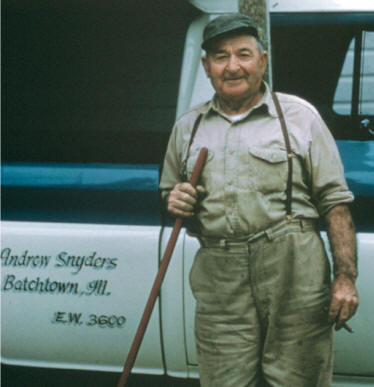
MR. ANDREW SNYDERS
OF BATCHTOWN, ILLINOIS
THE OWNER OF THE SNYDERS SITE
DURING THE EXCAVATION YEARS
Mr. Snyders was the owner of the Snyders site during the period of
time when Wadlow, Titterington, Perino, Struever, Griffin, Fecht and
many other people were digging there, beginning in 1940 through to
the 60's or 70's.
"Mr. Snyders allowed interested collectors
to dig in the site's deep bluff-base midden areas for a small fee
during the 1950's (2006 Farnsworth)." The Snyders name was used in
1951 by Scully to name one of the point types found on the site.
Snyders points are found on Hopewell sites in Michigan, Wisconsin, Illinois, Iowa,
Indiana, Ohio, Pennsylvania, New York, Northeastern Oklahoma,
Missouri, northwestern Arkansas and southeastern Kansas. The name
Snyders has become quite famous and can be found in many books that describe eastern Middle Woodland culture. |
|
|
The Snyders site is located in Calhoun County, Illinois five miles
north of Batchtown. It's situated at the foot of the eastern
Mississippi River bluff on a sloping terrace. It covers approximately
six to eight acres of the bluff-base slope. Hopewell culture burial mounds are located on
top of the bluff. |
|
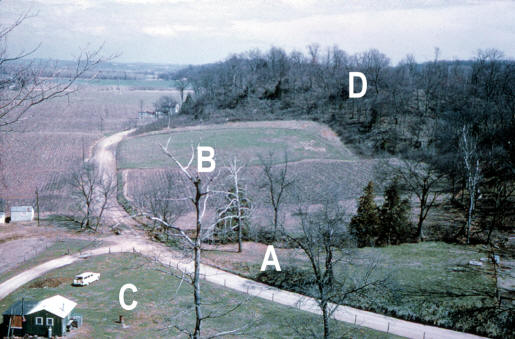
CLICK ON PICTURE FOR LARGER IMAGE
THE SNYDERS SITE
CALHOUN COUNTY, ILLINOIS
Most of the Snyders site can be seen in this picture. The areas
designated A, B, C & D are the locations where most of the digging
occurred over a period of approximately 30 years. A series of mounds
are located on the bluff top, at location D. Several burials and
some of the finer crafted artifacts were found there. The locations below, A, B
& C, produced artifacts from the village site. The Snyders farm
house is located to the right of the picture. The building at the
lower left is a club house. |
|
|
Over a period of thirty to forty years, the Snyders
site was extensively excavated. The owner of the site, Mr. Andrew
Snyders, allowed people to dig there, sometimes for a small fee. The
excavators included archaeologists James B. Griffin, University of
Michigan (1948 & 1949) and Stuart Struever, University of Chicago
(1960). Serious amateur archaeologists, who published reports, include
Greg Perino (1950's), Walter Wadlow (1940 & 50's), Dr. Paul F.
Titterington and William Fecht. Other people dug there primarily to add
to their private collections or to sell the artifacts on the commercial
market. |
|
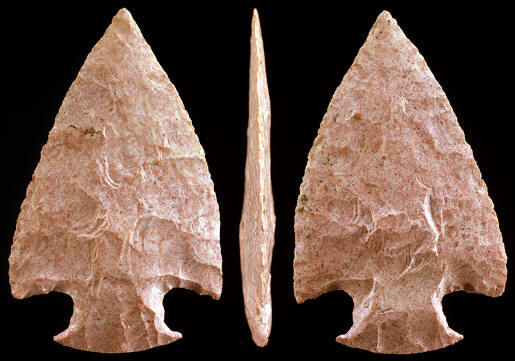
CLICK ON PICTURE FOR LARGER IMAGE
SNYDERS POINT
JERSEY COUNTY, ILLINOIS
MIDDLE
WOODLAND HOPEWELL
PRIVATE
COLLECTION
This fine and "classic" example of a Snyders point was found just
across the Illinois River to the east of the site in Jersey County.
It's made of heat treated Burlington chert and measures 3 1/16
inches (7.7 cm) long and 1 13/16 inches (4.6 cm) wide. Snyders
points were made in a wide range of shapes but most of them have
large corner notches and rounded bases. The Snyders site produced
large numbers of these points. Most of them are broken at their
bases. Only a small percentage are complete.
The Snyders point was named by Edward G. Scully in 1951 after the
Snyders site. |
|
|
The earliest inhabitants of the Snyders site are represented by Late
Archaic "Titterington focus" artifacts. Perino reports that a red ochre
blade was found and William Fecht discovered a cache of three Morse knives.
Both of these finds date to the Late Archaic and Early Woodland periods.
The latest component of the site is assigned to the Late Woodland Jersey Bluff
culture. Griffin writes in his 1952 summary about the site that, "---we
can say that the Snyders site is predominantly Hopewell with a
significant occupation of Jersey Bluff which postdates Hopewell." An
estimated age of the site is somewhere between 920 B.C. and A.D. 600. |
|
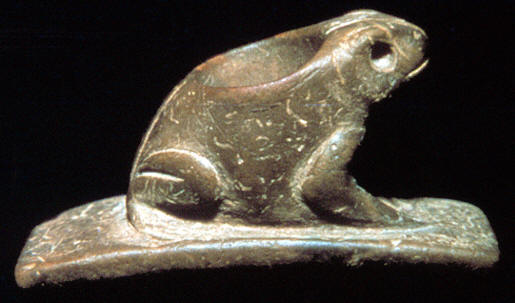
PLATFORM FROG EFFIGY PIPE
SNYDERS SITE
CALHOUN COUNTY, ILLINOIS
MIDDLE
WOODLAND HOPEWELL
PRIVATE
COLLECTION
Mrs. Walter Wadlow
found this frog effigy pipe in the Spring of 1951 after heavy rains
on a freshly plowed field. It's made of what William Fecht described
as "an unusual texture of banded limestone." It represents the best
complete example of a pipe found on the site. Several complete and fragments of
pipes are reported to have been found on the Snyders site. It's
probable that not all of them have been recorded. Walter Wadlow writes
about the subject in 1952, "The
contribution of folk lore to the history of the Snyders site is:
that pipes, and portions of pipes, have been found there since the
beginning of its cultivation. Specimens not badly damaged being sold
to "horse and buggy" buyers of Indian relics, who cared but little
about a pipe's history. Badly broken specimens possessed no
commercial value (and in those days scientific value) and were
thrown away, lost or destroyed." The Snyders site has produced pipes
made of pipestone, limestone, clay and even one fragment made of
pink Quartzite. |
|
|
The Hopewell village and the prolific numbers of artifacts that could be
found there are what drew so many people to dig on the Snyders site.
Farnsworth writes, "Greg (Perino) was personally familiar with the
artifact richness of the site's midden and well aware that extraordinary
artifacts being recovered there by casual excavators. Thus Snyders was
the first Gilcrease sponsored Illinois Valley site excavation he carried
out during May and June 1955 with local hired labor." The Snyders
burial mound group is located on the bluff top overlooking the village site below. An
estimated age for the Snyders site Hopewell component is somewhere between 100
B.C. and A.D. 400. |
|
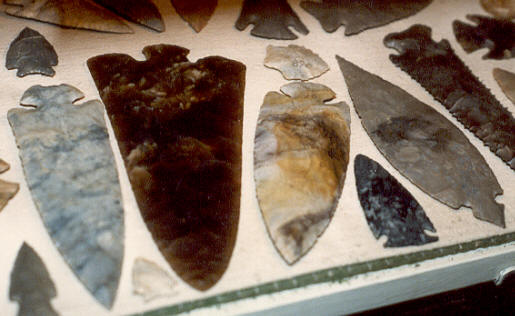
ROSS BLADE
SNYDERS SITE
CALHOUN COUNTY, ILLINOIS
PHOTO BY DENNIS VESPER--OF CLEM
CALDWELL'S COLLECTION
The large wide brown/amber colored point at left of center in this
picture is one of the most famous artifacts ever found on the
Snyders site. This Ross blade is extraordinary for its fine
craftsmanship and the fact that it's made of Knife River Chalcedony
from North Dakota. It's one of the finest crafted points ever found
in North America. A high level of skill was needed to make it. It
represents good evidence that there must have been full time craftsmen
within the Hopewell community. Some people were able to develop very
specific skills, in this case flintknapping. This
point was excavated in 1944 by Dr. Paul F. Titterington from Snyders
Mound C 114. It measures approximately 6 7/8 inches long. The other
points in the picture were, at the time the picture was taken, in
the collection of Clem Caldwell. |
|
|
The Snyders site produced a very wide range of both organic
and inorganic artifacts.
Organic materials like antler, bone, teeth and shell are very well
preserved. Bone artifacts include awls,
pins, combs, beads, gorges & carved effigies of bear teeth. Antler
artifacts include barbed antler projectile points and flintknapping
tools such as billets and pressure flakers. Drilled teeth were found from
several different animals such as bear, dog, wolf and even alligator.
Most of the teeth were drilled for suspension. Shell artifacts were found in
the form of beads, hoes, spoons & a carved effigy of a bear tooth.
Turtle-carapaces were also found that were used as vessels. Stuart Struever
was impressed with the organic preservation at the Snyders site and
wrote, "Certainly as exciting as any of the hundreds of artifacts
recovered was a quantity of carbonized plant remains taken from three
Middle Woodland features. Plant remains have seldom survived, or at
least seldom have been recovered, from sites on a Woodland horizon in
eastern North America." |
|

NORTH POINT CACHE
SNYDERS SITE
CALHOUN COUNTY, ILLINOIS
MIDDLE
WOODLAND HOPEWELL
PRIVATE
COLLECTION
This cache of North points were found by Harvey Suhling on the
Snyders site. They represent some of the finest flint-work ever
found on a Hopewell site in Illinois. Their thinness to width ratio is quite exceptional. They are made from
heat treated Burlington chert. |
|
|
Large numbers of
broken ceramic pots were collected on the Snyders site. They were found
in a wide variety of designs. The counting and cataloging of the broken
fragments helped identify the different cultural groups that once lived
there. The variety of pottery designs allowed archaeologists to separate
different periods of occupation. By far the most elaborately designed
ceramics were made by the Middle Woodland Hopewell people. Probably more
than 99% of the pots found on the Snyders site are broken fragments. But
from these fragments the site produced what were once engraved pots with
stylized versions of birds and pots with a variety of artistically
stamped designs. Another decoration technique used a stick to push small round protrusions
from the inside to the outside of the rim of the pot. Some of the
descriptive terms used to describe Hopewell ceramic designs are
rocker-dentate stamped, bar stamped, zone-incised, cord-wrapped-stick
decorated, Montezuma punctated, and many many more. |
|
CONTINUE ON TO PAGE
TWO
|
|
"REFERENCES"
1952, Wadlow, W. L. "The Snyders Site," The Greater St. Louis
Archaeological Society, p. 2.
1952, Griffin, James B., PhD, "The Snyders Site," The Greater St.
Louis Archaeological Society, p. 2.
1961, Fecht, William G. "The Snyders Mound Group and Village Site," Central States
Archaeological Journal, Vol. 8, No. 3, p. 84.
1961, Struever, Stuart PhD.,
"Further Excavations at the Snyders Site; An Analysis of Snyders
Ceramics," Central States Archaeological Journal, Vol. 8, No. 3,
p. 94.
1968,
Montet-White, Anta, "The Lithic Industries of the Illinois Valley
in the Early and Middle Woodland Period," pp. 93, 119 & 124-127.
1969, Fecht, William G. "Additional Information From The Snyders
Site," Central States
Archaeological Journal, Vol. 16, No. 2, p. 63-77.
1985,
Perino, Gregory, "Selected Preforms, Points and Knives of the North
American Indians, Vol. 1" pp. 17, 262 & 358.
2006, Farnsworth, Kenneth B., "Certain Hopewell And Late Woodland Sites In Illinois, Perino Memorial
Volume," Introduction: Gregory Perino's
Archaeological Career and Illinois-Excavation Photo Essay, p. 4, and
The 1955 Snyders Village Site Excavations, Calhoun County, Illinois,
pp. 71-80.
2006, Farnsworth, Kenneth B., "Certain Hopewell And Late Woodland Sites In Illinois, Perino Memorial
Volume," The Snyders Site Walter L. Wadlow, pp. 120-126.
|
|
RECENT
LISTINGS HOME
ORDERING |
